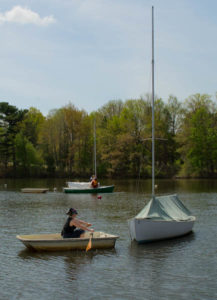
This week I’m thinking about anxiety as a disorder, and anxiety as part of being human.
It’s part of the human condition that can never be 100% sure of anything. We can’t know that our loved ones to whom we said goodbye five minutes ago are safe. We can’t know whether we will have an aneurysm or a stroke or a heart attack in the next hour. We can’t be sure that scientists haven’t missed an asteroid heading for us. A new epidemic could start at any time.
In CBT and Acceptance and Commitment Therapy, we have a paradoxical stance towards anxiety. We encourage anxious clients to verbalize and accept the possibility of what they fear. We also talk about the actual odds of these things occurring. By definition, an anxious person worries a lot more than the ‘average’ person. However, even though the likelihood of a feared event occurring may be tiny, it’s usually not zero.
Being anxious is being unable to tolerate uncertainty.
Anxiety and Mindfulness
My goal is to help clients to be able to live with the uncertainty of life. When we are anxious, we fear the thoughts and images in our own minds. Reacting to these makes them worse, not better. If you call your spouse repeatedly to check that she is safe, this reinforces the belief that she is in a dangerous situation. Reassurance-seeking lowers the fear temporarily, but reinforces the idea that checking is necessary. It encourages overestimation of risk.
I teach anxious clients mindfulness skills. Many people think that mindfulness is about having a peaceful, quiet mind. However, this is more of a long-term result of practice. For most people, mindfulness is about being able to notice whatever comes up. This will include both fearful thoughts and images, and trivia about what you need to pick up at the supermarket, etc. Mindfulness is training yourself to notice the thought or image, and let it drift away, neither pushing it away nor clinging to it. The point is to notice, to be present to what is happening in your mind, not to escape. Mindfulness helps you tolerate whatever horrors your anxious mind brings up. This is what we call ‘exposure’ in CBT.
Anxiety and the Human Condition
In many situations that we worry about things over which we have no control. Thus, there is no point in worrying. Lack of control, is, ironically, freedom.
This is what links anxiety disorders with anxiety as the human condition. We all worry because we are attached to things and to people. “Enlightened” people of all traditions have accepted the potential for loss, and the anguish that goes with it. They have the joy of freedom, but it is certainly not a kind of easy way out. The rest of us can benefit from going as far in this direction as we can.
Anxiety in Society
A few months ago, I was listening to the new NPR radio show “Invisibilia” (a very interesting program about the mind.) There was a discussion of the increase in parents’ fear over the last couple of generations. Kids in the ‘old days’ had whole neighborhoods to explore. Now parents are afraid if they are out of sight/contact for more than a few minutes. But the dangers of this kind of freedom for kids are actually no greater than they were in the past. The problem is that we are more aware of them because of the media.
There are costs for trying to reduce uncertainty to zero. Kids cannot develop the same sense of competence, of knowing how to get around and explore and cope. And how we react to situations shapes what our children believe is an appropriate response. Parents can increase anxiety in children by modeling anxious behavior. We can teach kids to believe that zero uncertainty is a viable goal.
How can we love and plan and dream and yet be at peace with having so little control over our lives? And how can we model to kids that this is the only way to be happy?
